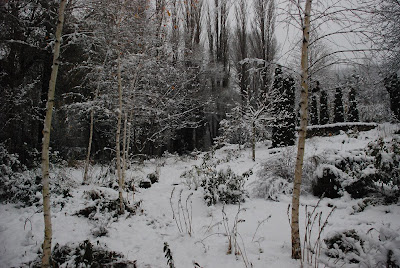You can see it in front of the birch in the middle, between the thuya and the rose. At us it grows on a rather shady place. On a sunny place it get much more yellow.

It was one of my best gardening catches. I bought it some years ago in the New Garden nursery as a completely developed plant. On a deeply reduced price, as nobody bought it. But I at once fell in love with it.
 Here it is at the left side of the picture, in the middle of the summer. Beautiful, as throughout all the year.
Here it is at the left side of the picture, in the middle of the summer. Beautiful, as throughout all the year.
 Its form is so architectonic that one can put it even in a Japanese garden, as they often do it indeed. But it also fits well to our more colorful, loose mixed flower bed.
Its form is so architectonic that one can put it even in a Japanese garden, as they often do it indeed. But it also fits well to our more colorful, loose mixed flower bed.
 In the autumn it assumes beautiful colors. It also produces berries, but at us unfortuntely quite few. In has a spectacular form also in the winter, here behind the birch to the right.
In the autumn it assumes beautiful colors. It also produces berries, but at us unfortuntely quite few. In has a spectacular form also in the winter, here behind the birch to the right.

It is quite frost-hardy (Z4). It grows about one meter hight and one to one and half meter large. People often recommend to plant it on an light soil, but at us every Berberis thunbergii feels better on adobe soil than on sand. However, it cannot stand soils with bad drainage. (This is no problem at us, as all our soils drain water better than necessary.) It loves sunny or partly shady places. It works well in dry places. That is, it is perfect of its kind.
 Here it is at the left side of the picture, in the middle of the summer. Beautiful, as throughout all the year.
Here it is at the left side of the picture, in the middle of the summer. Beautiful, as throughout all the year. Its form is so architectonic that one can put it even in a Japanese garden, as they often do it indeed. But it also fits well to our more colorful, loose mixed flower bed.
Its form is so architectonic that one can put it even in a Japanese garden, as they often do it indeed. But it also fits well to our more colorful, loose mixed flower bed. In the autumn it assumes beautiful colors. It also produces berries, but at us unfortuntely quite few. In has a spectacular form also in the winter, here behind the birch to the right.
In the autumn it assumes beautiful colors. It also produces berries, but at us unfortuntely quite few. In has a spectacular form also in the winter, here behind the birch to the right.
It is quite frost-hardy (Z4). It grows about one meter hight and one to one and half meter large. People often recommend to plant it on an light soil, but at us every Berberis thunbergii feels better on adobe soil than on sand. However, it cannot stand soils with bad drainage. (This is no problem at us, as all our soils drain water better than necessary.) It loves sunny or partly shady places. It works well in dry places. That is, it is perfect of its kind.

4 comments:
Yonaput!
I wonder if that would do well in my zone 4/5??
it has interesting foliage.
Hope you are well!!
Dear Anne-Marie,
I'm so happy to see you here.
I think it should be OK at you, too. In the reality our garden is Z 4/5 too, and the barberry survived even those two winters when temperature was under minus 26 even in the daytime for several days.
Thanks, now I'm a little bit better.
With love, Kata
Well, mi litle B. aurea is alive at least. Its first leafs are starting now, in april... interesting photos, mine is much smaller gets much more sun and i'm expecting now to see the gold lime leafs fully developped
All big shrubs start as small ones... and how beautiful it will be with the gold leaves!
Post a Comment